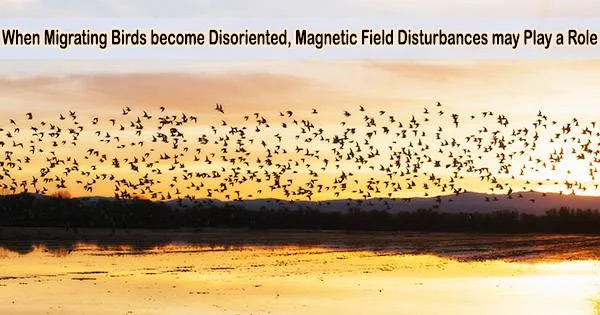It appears plausible that severe weather can occasionally cause birds to become lost during their yearly fall migrations, forcing them to end up in unfamiliar terrain.
But why, even when weather is not a major factor, do birds travel far away from their usual routes?
A recent article by UCLA ecologists investigates one reason: fluctuations in the Earth’s magnetic field can drive birds astray, a phenomena scientists term “vagrancy” even in perfect weather, and especially during fall migration. The research is published in Scientific Reports.
With bird numbers in North America gradually dropping, determining the reasons of vagrancy could help scientists better understand the risks birds encounter and how they adapt to those threats.
For example, birds that wind up in unfamiliar territory are likely to face challenges finding food and habitats that suit them, and may die as a result. However, it may also benefit birds whose traditional habitats are becoming uninhabitable as a result of climate change by “accidentally” introducing the animals into geographical regions that are now better suited to them.
The magnetic field that runs between the North and South Poles on Earth is caused by a variety of variables both above and below the planet’s surface. Decades of laboratory studies indicate that birds can detect magnetic fields using magnetoreceptors in their eyes. The new UCLA study lends support to those findings from an ecological perspective.
“There’s increasing evidence that birds can actually see geomagnetic fields,” said Morgan Tingley, the paper’s corresponding author and a UCLA associate professor of ecology and evolutionary biology. “In familiar areas, birds may navigate by geography, but in some situations, it’s easier to use geomagnetism.”
We think the combination of high solar activity and geomagnetic disturbance leads to either a pause in migration or a switch to other cues during fall migration. Interestingly, birds that migrate during the day were generally exceptions to this rule they were more affected by solar activity.
Benjamin Tonelli
However, when geomagnetic fields are disrupted, birds’ ability to navigate using them is compromised. Such disruptions can be caused by the sun’s magnetic field, for example, especially during periods of increased solar activity, such as sunspots and solar flares, but they can also be caused by other sources.
“If the geomagnetic field experiences disturbance, it’s like using a distorted map that sends the birds off course,” Tingley said.
Lead researcher Benjamin Tonelli, a UCLA doctoral student, worked with Tingley and postdoctoral researcher Casey Youngflesh to compare data from 2.2 million birds, representing 152 species, that had been captured and released between 1960 and 2019 part of a United States Geological Survey tracking program against historic records of geomagnetic disturbances and solar activity.
While other factors such as weather are probably more important in causing vagrancy, the researchers discovered a strong correlation between birds captured far outside of their expected range and geomagnetic disturbances that occurred during both fall and spring migrations. But the relationship was particularly pronounced during the fall migration, the authors noted.
Geomagnetic disruptions hampered the navigation of both young and old birds, implying that birds rely on geomagnetism in the same way regardless of their level of migration experience.
The researchers predicted that geomagnetic disruptions caused by increased solar activity would be associated with the greatest vagrancy. Surprisingly, solar activity lowered the rate of vagrancy.
One possible explanation is that the radiofrequency activity caused by solar disturbances may render birds’ magnetoreceptors inoperable, forcing birds to rely on other cues to navigate.
“We think the combination of high solar activity and geomagnetic disturbance leads to either a pause in migration or a switch to other cues during fall migration,” Tonelli said. “Interestingly, birds that migrate during the day were generally exceptions to this rule they were more affected by solar activity.”
Despite the fact that the researchers only looked at birds, their methodology and findings may help scientists understand why other migratory animals, such as whales, become disoriented or stranded far from their regular region.
“This research was actually inspired by whale strandings, and we hope our work will help other scientists who study animal navigation,” Tingley said.
Tonelli created a web-based program that tracks geomagnetic conditions and forecasts vagrancy in real time to make the research more accessible to birdwatchers. The tracker is inactive for the winter, but it will reopen in the spring when migration resumes.





